In Discussion with:
Valeria Napoleone,
Art Collector and Founder of Valeria Napoleone XX
“I like to create a journey with individuals. I never journey alone. I truly believe that you cannot build a relevant and ambitious collection alone - you need the support of people.”
Valeria Napoleone has been a collector for 23 years, focusing exclusively on the work of female contemporary artists working internationally. She is head of the Development Committee at Studio Voltaire, a London based nonprofit; a trustee of the Contemporary Art Society; on the boards of trustees at NYU Institute of Fine Arts; a member of NYU President’s Global Council and an advisory board member of the Association of Women in the Arts. Valeria has been an avid supporter of many UK based institutions such as Nottingham Contemporary, ICA London, and Whitechapel Gallery amongst many others.
In June 2015, Valeria launched “Valeria Napoleone XX”, an umbrella platform for projects and artists that works for increasing the representation of female artists in major public institutions. “Valeria Napoleone XX Contemporary Art Society” is an on-going commitment to purchase and donate a significant work by a living female artist with different museum reach each year - in 2019 this initiative received the prestigious Montblanc Art Patrons Award.
“Valeria Napoleone XX Sculpture Center” is an ongoing commitment to underwrite the production of a major commission every 12-18 months at this New York based non-profit art institution dedicated to sculpture. In 2012, Valeria published her first book, an art cookbook with a contribution from 50 female artists.
Valeria, would you be able to tell us about your journey into art collecting and what part of the process holds most significance for you?
Yes, it’s a pleasure, it's always very special for me to be able to share my journey with artists. Since the very beginning, I had this excitement of being part of a community, really, it was not just about buying a piece, but it’s also just about spending afternoons in artists’ studios and having fun discussing the work. Since the very beginning, I realised how important it was for me to have the connection with the artists. I always say that I was born at the right time in the right place as a collector in 1997, two years after I started my masters in Art Gallery Administration at FIT in New York, through which I met so many individuals who were really important, so relevant for what I'm doing now. I learned so much and I didn't collect or didn't buy anything for two years, I just spent time listening and looking.
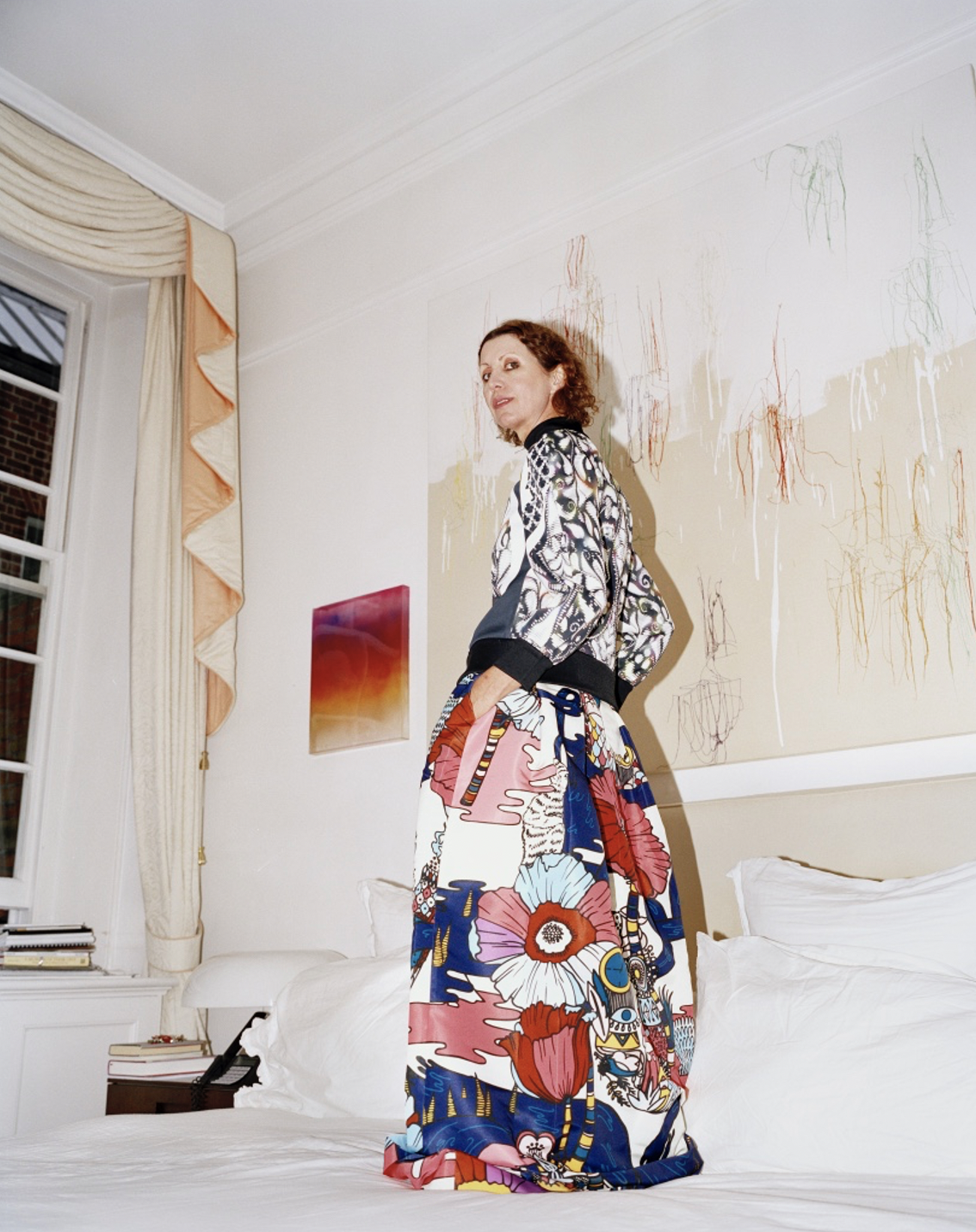
Valeria Napoleone in front of Ghada Amer's Colour Blanche.
Courtesy of Valeria Napoleone.
So, one of the first artists we want to talk about is Ghada Amer.
Ghada Amer was one of the very first artists in my collection. Actually, she told me that I was her first collector! Ghada remembered when I hung her painting in New York in my dining room she was so surprised. And I said "what why? What do you mean? I mean, it's an artwork, and you know, we enjoyed it every day”. Then she said "well it usually ends up above the bed." I don't know if it was because of the erotic scenes that she embroidered or because she was a young artist and people didn't really understand her work.
Either way, we’ve had a journey of friendship since then. I discovered her work through a friend who hosted a group show where Ghada was included. I bought this painting which is called Colour Blanche and on that occasion I met Ghada on the elevator going up to an apartment of a person who was hosting a dinner for Ghada.
We met in the elevator and the rest is history!
Did this work travel with you? Overall do you live with your artwork, it’s not in storage?
I make a point of displaying each work that enters the collection for at least three years and they rotate quite organically in the house. Pieces might go into storage, or to museums and exhibitions and our home is a very dynamic place. You know, no matter how much space you have, or many houses you have, for a collector it is impossible to show everything. I used to host a lot of dinners at my place. I haven’t so much in the past year, which has been quite difficult because being part of a community and establishing connections and communications is so important to me. After all, contemporary art is about communication and discussion.
Usually we host between 6-12 dinners a year of 80-100 people, and it's all about bringing the community and creative minds and generous individuals together. These dinners are usually to celebrate an artist in the case of a solo show in a museum or gallery;
to fundraise for publications and projects; to welcome artists into London and to gather with the community.
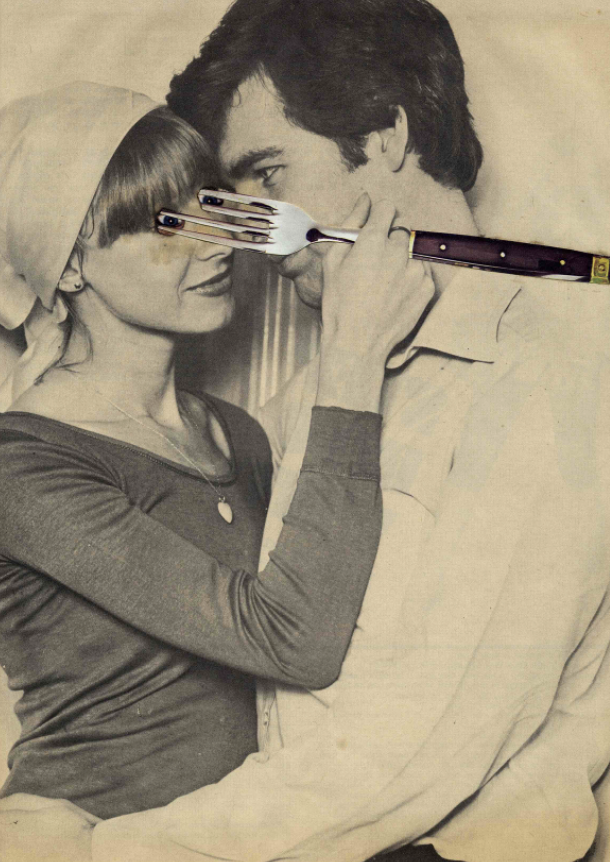
Linder, Untitled, 1977.
Courtesy of Valeria Napoleone, excerpt from the book, Exquisite Recipe, 2009, Koenig Publishers.
Your dedication to hosting gave rise to a very special publication, Valeria Napoleone’s Catalogue of Exquisite Recipes, how did this project come about?
My journey with all these incredible, talented individuals is a journey of mutual support. And, you know, it's also a journey of a lot of fun. These connections with artists also helped me greatly with the Cookbook project I started in 2009 with artists from my collection. I included 50 artists who were all so excited to do something new!
Around 70% of the pieces are done for the book specially and around 30-40% are given to me by artists from their own archives. I was touched because the role was reversed and I was the one asking them for support.
How important to you are these friendships that you create with artists and trusted gallerists? Do they help in your collecting process?
These friendships are so important, I like to create a journey with individuals. I never journey alone, and I truly believe that you cannot build a relevant and ambitious collection alone, you need the support of people. I don't have art consultants, or curators for my collection or within my life as a patron. However, I always say that the best consultants
I have are artists, gallerists, curators, communities - the web of support that I appeal to throughout the years. This is a journey of personal discovery, so I get excited about surprises. I also get excited when I can lend a hand to people, situations, projects or institutions that really need it most. I consider myself a very courageous and adventurous individual, so I connect to people who have courage and go after what they believe in.
For me, an institution like Studio Voltaire is one of the most courageous and radical and experimental places not only in London, but in the world. Phyllida Barlow is one of the many artists to whom Joe Scotland and Studio Voltaire gave a platform. It was also much later in her life, she had been teaching for so long, being a mentor to so many important artists of a younger generation, and she had not really been discovered or looked at so finally she’s where she should be. Studio Voltaire really put her on the map and supported her practice, like with many other artists.
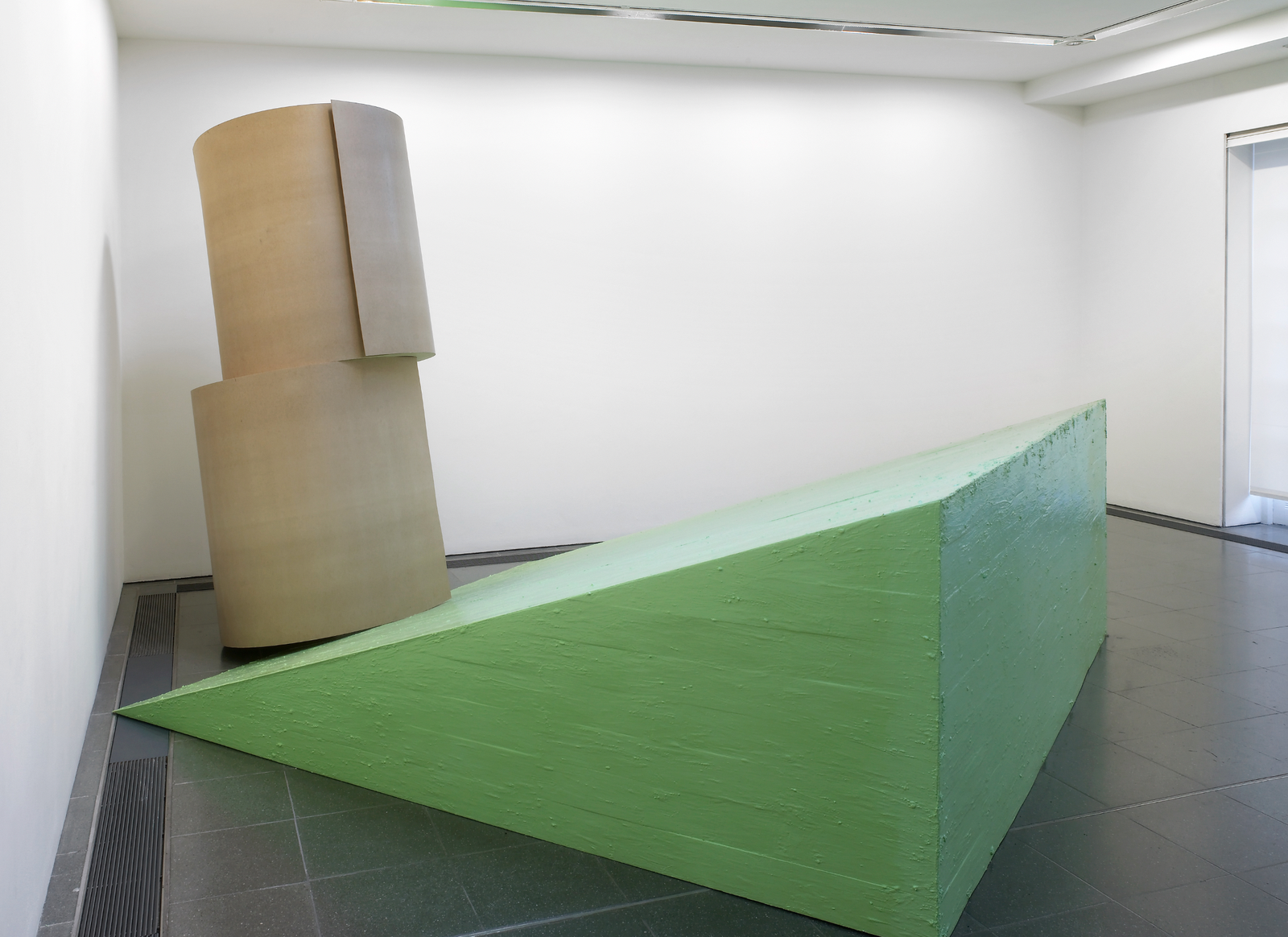
Phyllida Barlow, Untitled: Ramp-drums, 2010.
Installation view, Serpentine Gallery, London, 2010.
© 2010 Phyllida Barlow. Photograph © 2010 Raphael Hefti.
Courtesy of the artist and Serpentine Gallery.
AL
This seems to be one of the characteristics of your collecting: you go either for unrecognised voices or emerging talents. There’s a great focus on women artists who still have a lot of room to grow in terms of their awareness and recognition.
VN
Absolutely, I think my help and support becomes even more meaningful in those situations.
Here is Phyllida’s exhibition at the Serpentine, and the green sculpture is in my collection.
It’s too big to get through the entrance door, but eventually it will make it inside!
Part of the collection was also hosted in Sheffield in the Rochdale museum.
It was a fantastic exercise, not only to support these museums and loaning pieces for their collections and for the public but also for their community, it allows you to really see the work in a different context. Curating the shows together with the curators and museums engaging with the community, directors and curators has also been a really incredible journey.
These museums often don’t have the opportunity, means or funds to collect contemporary art,
so the support from private collections to loan pieces is essential.
AL
Absolutely, and you talk about this as a stepping stone from being an art buyer to being a real art collector and a patron. The different milestones that come with sharing the works with the public, either through loans or patronage. There was a turning point in 2016 with “Valeria Napoleone XX” which distinguished you very much in terms of the leadership you displayed. You also received the Montblanc Award which was a great recognition for the initiative, and all your years of advocacy and support for artists!
VN
The “XX” initiative officially started in 2015 but it is the formalisation of what I’ve been doing since 1997, supporting institutions, artists and the production of pieces and projects. In 2015, I found myself asking how can I scream, instead of just whispering, about the necessity of support for female artists for them to be able to enter museums and commercial spaces. I thought maybe if I package it, call it something, people would pay even better attention. We decided on the name “XX” which stands for the female chromosome because it also stands for partnership. As I’ve mentioned, my life as a collector has never been alone and I believe that with a partner, with like-minded individuals, you really can go much further than if you go by yourself. That’s the core of “XX”.
At the time, the Contemporary Society was asking me to become a trustee and I was very flattered to be asked, but I was also thinking about how I could maximise my involvement with this organisation that has been around for over 100 years. We started an initiative where every year we donated a work by a female artist to an original museum that was part of their organisation. In the applications, museums have to answer a very specific questionnaire about the number of female artists they have in their collection and the actions they are taking to address the gender imbalance so they are really asked to look into their archival ties into their collections. Every year we see 10-25 museum applications who have, at most between 0-5% female artists in their collections. It's more of a catalyst for change than actually changing and more an act of filling out these black holes that are there in their collections, change starts with discussion and awareness.
We have a committee consisting of four people, me, the director of the Contemporary Art Society, the director of acquisition and the director of the museum. We contribute four or five names each and through a discussion we decide the artists that enter the collections.
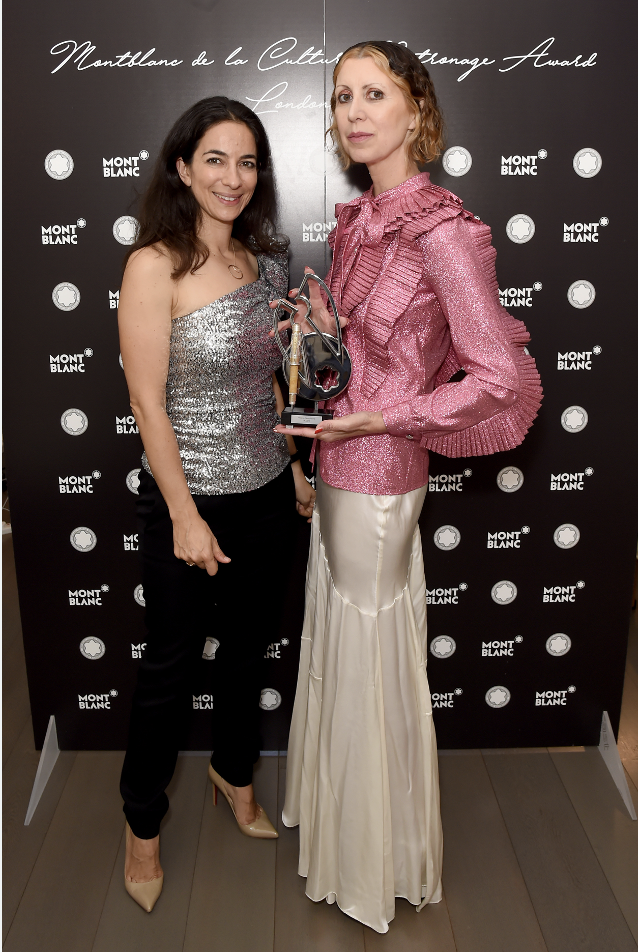
Montblanc Arts Patronage Award for her work with the VN XX CAS Initiative, 2019.
Courtesy of Valeria Napoleone and the Montblanc Cultural Foundation.
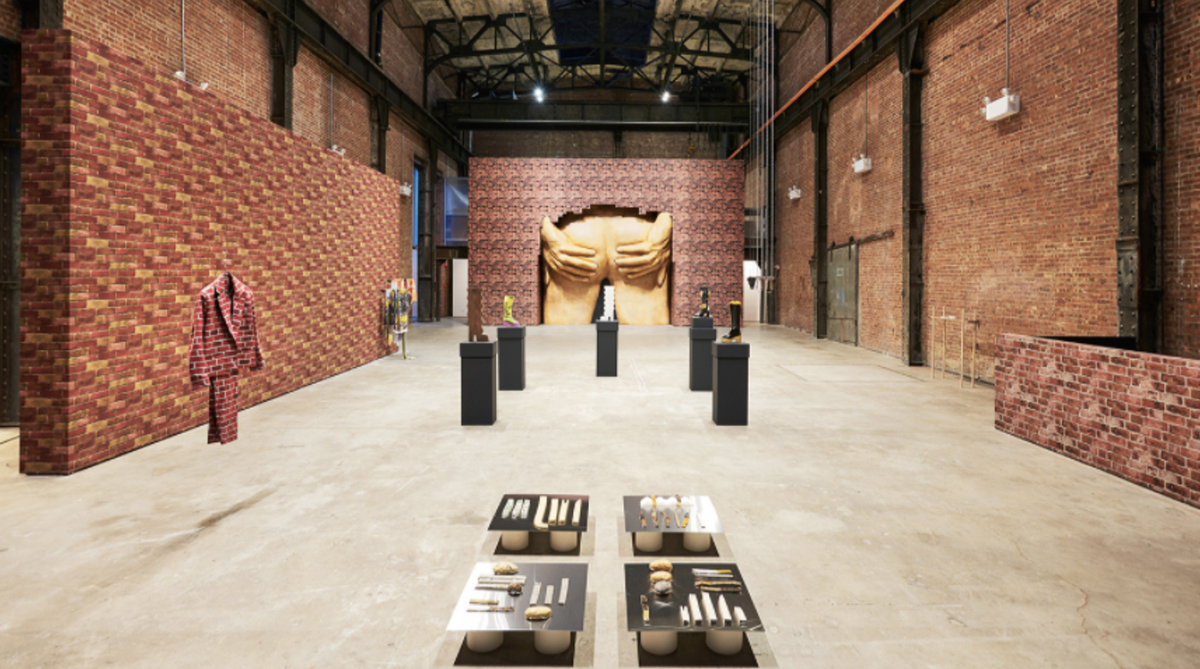
Anthea Hamilton: Lichen! Libido! Chastity!, 2015–2016, Sculpture Center, New York.
Courtesy of the Artist and Sculpture Center.
XX also supports artists through the production of new work for exhibitions. Can you talk about your involvement with Sculpture Center and your work with Anthea Hamilton in 2016?
Yes, Sculpture Center isn’t a museum, it doesn’t buy works, it doesn’t have a collection but it is an exhibition space. It was founded by a female artist and it has never had a male director until recently. It’s a very courageous space, they give opportunities to artists that are under the radar and not recognised - everything that I stand for.
It’s important to note that “XX” doesn’t give the funds to the Sculpture Center but it gives funds for the production of commissions, because I wanted the connection to be as personal as possible in my life, as a collector, as a patron. When they told me they were thinking about exhibiting Anthea Hamilton, they came to me with a picture of a project that was never realised, a doorway for an entrance to a skyscraper in New York.
It was so irreverent, so radical and we did it in September 2015. Anthea was nominated for the Turner Prize for the show at the Sculpture Center where she really took centre stage.
It is so exciting to see the work coming to life and to be so deeply connected to it.
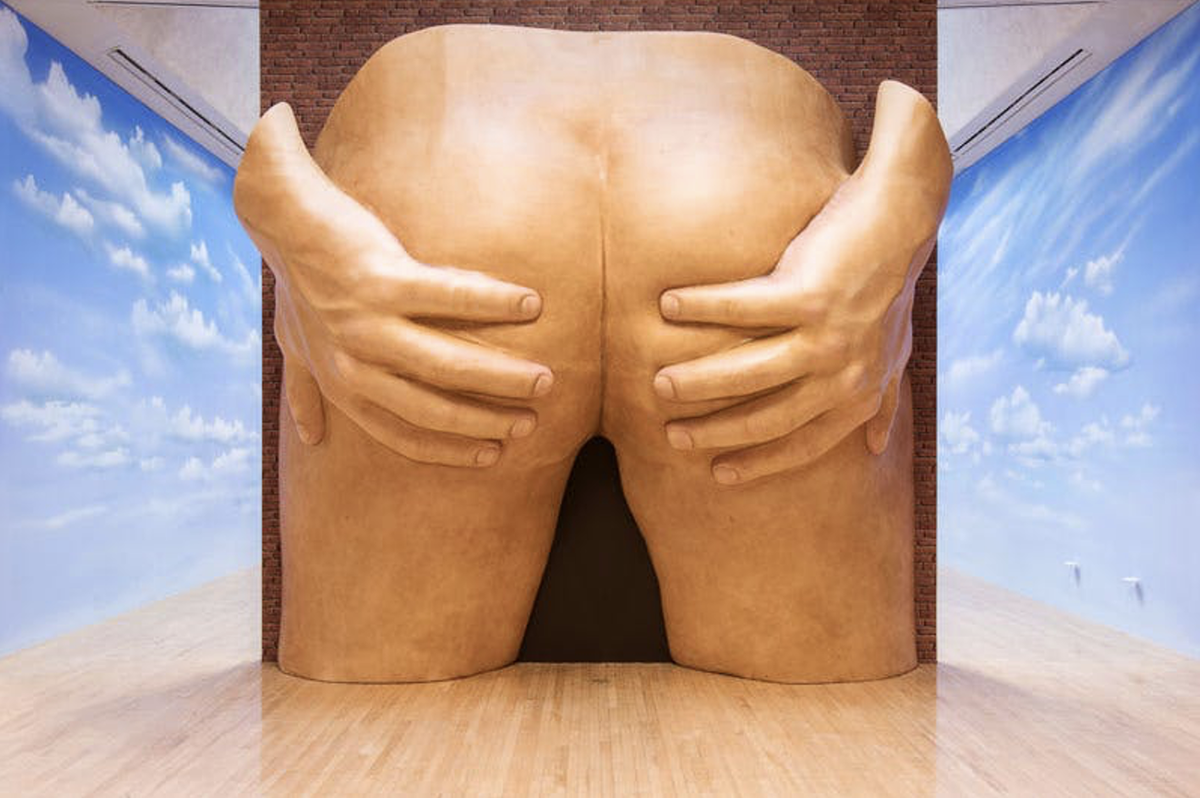
Anthea Hamilton, Project for a door (after gaetano pesce), 2016, Installation view, Turner Prize, Tate Britain, London.
Courtesy of the Artist and Tate Britain.
I would imagine that quality and the idea of uncompromising artistic excellence plays into your decisions to support or collect a piece.
Absolutely, every piece that enters the collection is one that I believe to be a piece of high quality. “XX” is really about supporting exceptional practices. I sit on the board of the Institute of Fine Arts (IFA) and I wanted to push them further by doing a project that would be a catalyst for change, nurture the life of the Institute and also further my commitment for female artists. Twice a year we select four students for the IFA who will be able to enter a solo exhibition for a female artist in the Great Hall. The important part of the IFA is not only that it is an exhibition space, but that it is organised by students and creates a programme around the shows; performances, panels, critical and analytical writing on the practices of female artists. This is key as most female artists are absent from art history because there is nothing written about them.
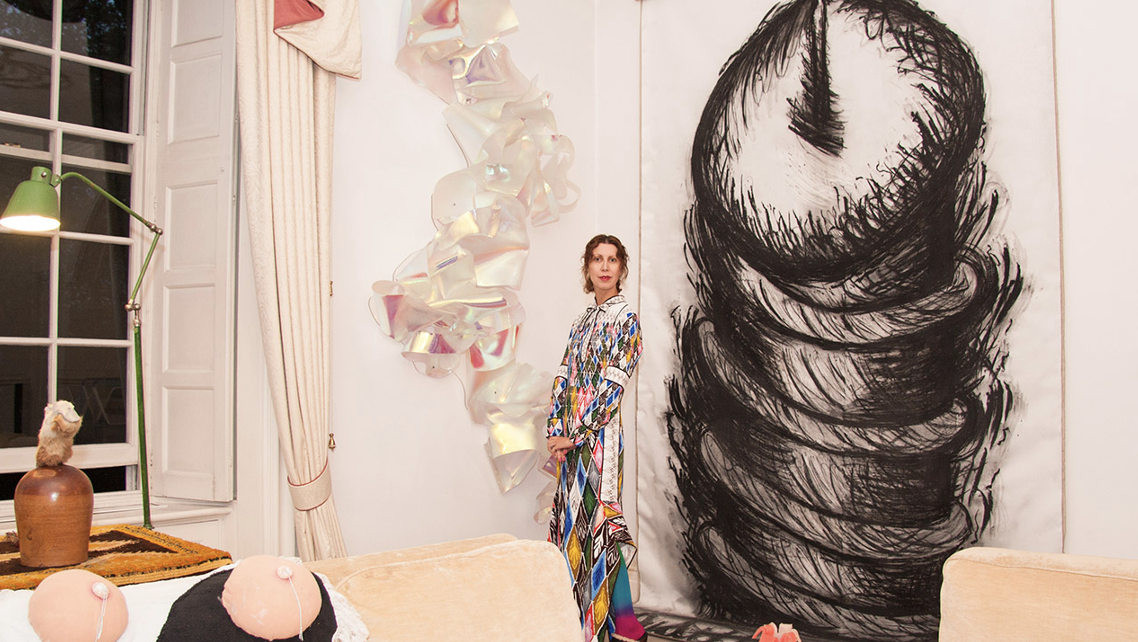
Judith Bernstein, Screw 1, 2014.
Photo: James Champion.
Courtesy of Valeria Napoleone.
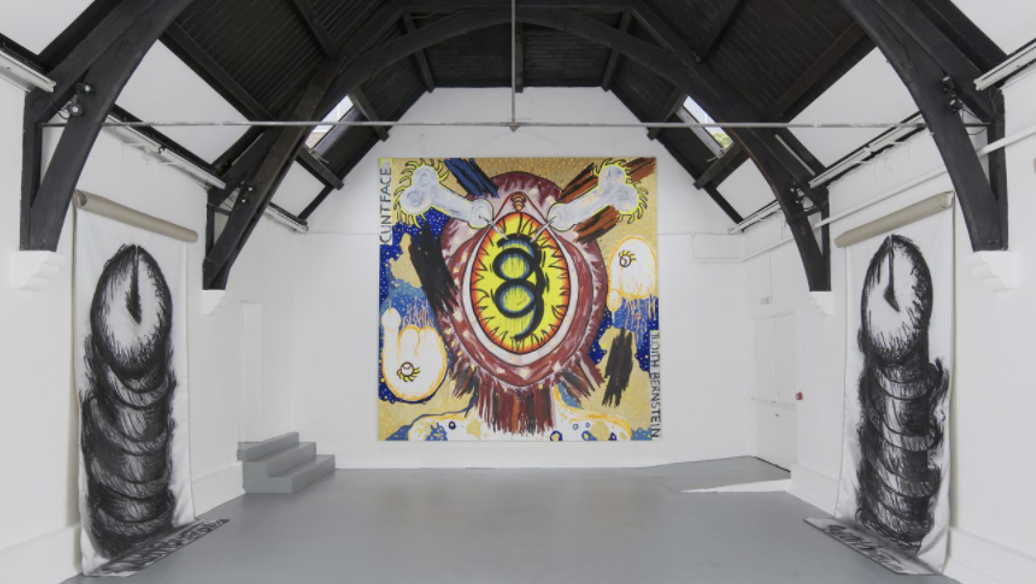
Judith Bernstein, Rising, 2014.
Installation View, Studio Voltaire, London.
A Studio Voltaire commission.
Credit: Andy Keate.
Courtesy of the artist and The Box, Los Angeles.
Could you tell us a little more about the artists and works you yourself own, and also some of the voices that were recognised later like Judith Bernstein, for instance?
Judith is a force of nature! The first museum or institution that showed her work was Studio Voltaire in 2014. She spent one month in residency there and every morning she spent 12 hours in the gallery working like crazy. The piece in the chapel was at the time, the biggest piece she had done. The other pieces are screw paintings taken from the 1970s on canvas with charcoal. It is such an intense process for her to come up with these incredible exhibitions.
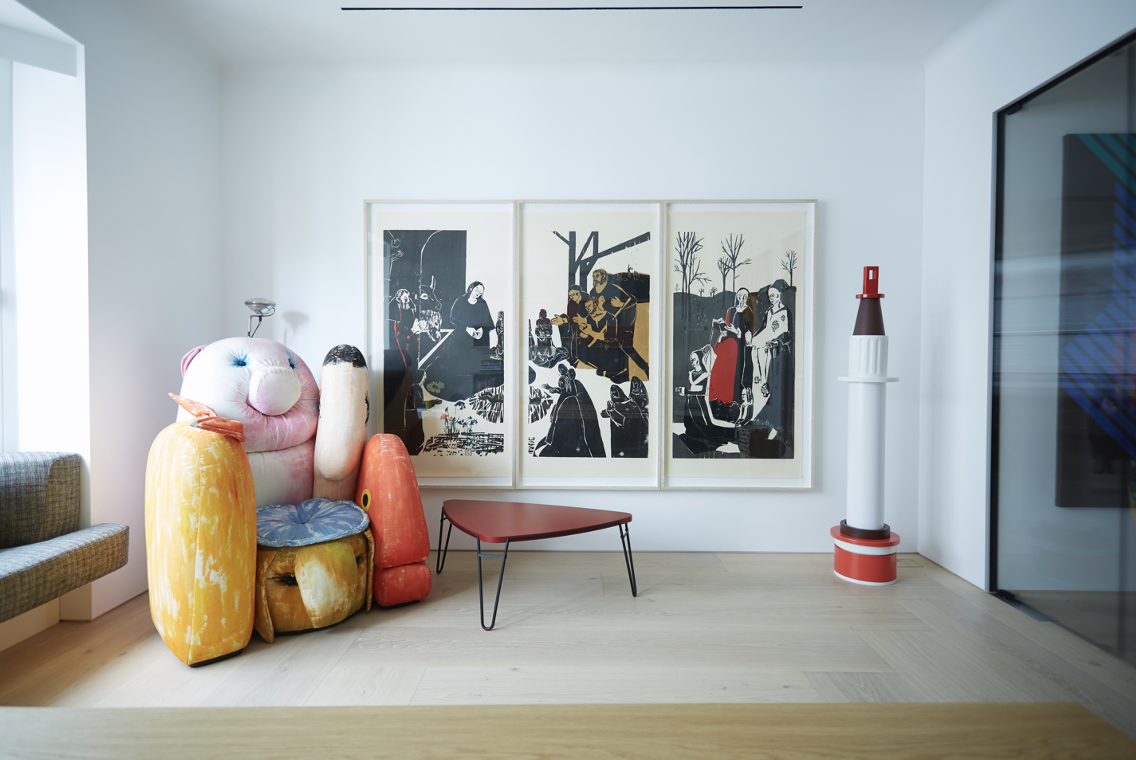
Andrea Büttner, Nativity, 2007.
Photo: James Champion.
Courtesy of Valeria Napoleone.
The next artist we’d love to talk about is Andrea Büttner.
Andrea is an artist really close to me. I discovered her practice when I was serving as a judge for the Max Mara Prize in the Whitechapel Gallery. Andrea was one of the proposed artists and she ended up winning the prize, it was a real stepping stone for her career.
She is one of the most intelligent people I know, with an incredible mind and has a very conceptual practice. Her work is so unpretentious, so simple, direct and it touches on keynotes about life. It's very poetic work, but quite tough.
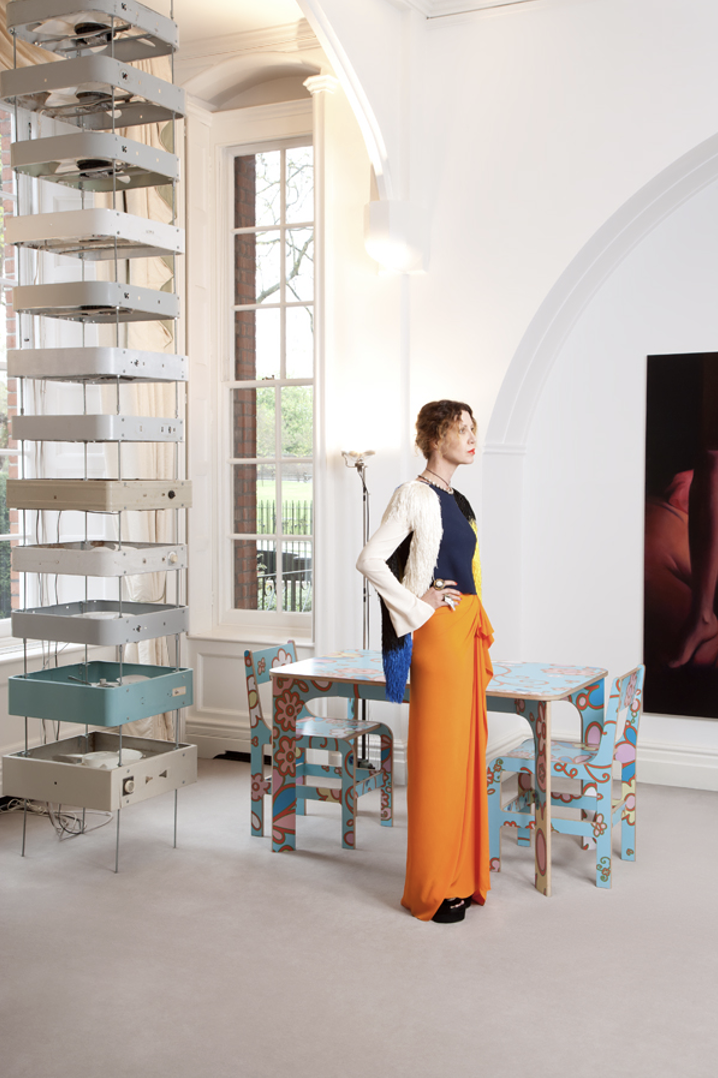
Nina Canell, Endless Column (Alternating Current for Twelve Electric Fans), 2009.
Photo: Philip Sinden.
Courtesy of Valeria Napoleone.
AL
Our next artist we’d love to talk about is Nina Canell.
VN
This piece from Nina Canell is called Endless Column, hanging in our place in London. It’s made up of 12 fans found in New York apartments in the 1980s and each one has a different colour tone, a different personality. They are activated electrically with a switch, they spin on a timer so each is activated at a different time. It’s a very powerful piece, each one has a different voice, different strength and different noise.
Her pieces really highlight forces and energy that we don’t pay attention to in everyday life.
“I don’t know the meaning of a risk, I’m courageous as a collector, I can do whatever I want, I can choose the artists I love”
We also want to talk about Nicole Eisenman, would you mind telling us about how you discovered her work and the pieces in your collection?
Nicole’s first show in the UK was at Studio Voltaire, where you can see her first transition as a sculptor as well. As for all the artist studios, this is a place that gives total freedom to the artist to do whatever they want as there is no pressure to sell the work.
These pieces were built in the gallery, eventually the vast majority were destroyed because they could not be transported or separated from the floor.
This was also the first time she experimented with sculpture, after this show you can see her also experiment with this at Carnegie International and started her whole journey in sculpture.
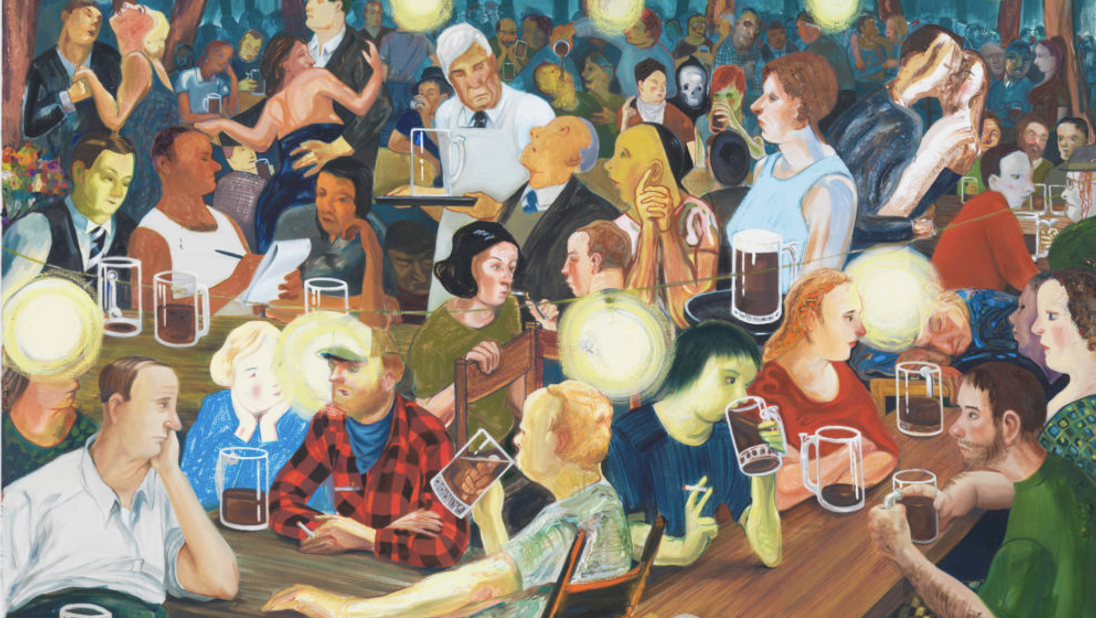
Nicole Eisenman, Brooklyn Biergarten II, 2008.
Courtesy of the Artist and Valeria Napoleone.
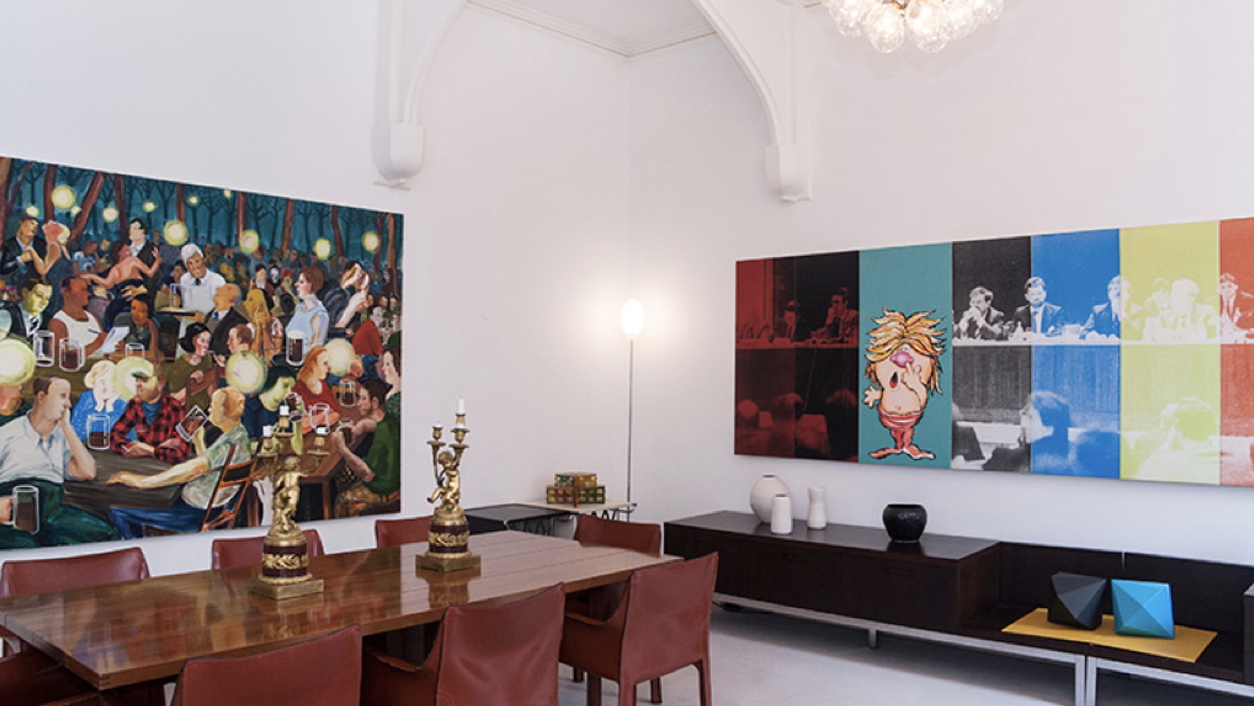
Nicole Eisenman, Brooklyn Biergarten II, 2008.
Installation view.
Photo: Mariona Otero.
Courtesy of the Artist and Valeria Napoleone.
What do you say to them in terms of pushing the boundaries of what we consider beautiful or aesthetic? I'm sure that they're used to it by now since they’re grown, but how do you approach those kinds of conversations?
We discuss pieces, when they ask, I never lecture them on pieces. Art is very natural in our place, it’s about life, and contemporary art is about contemporary life.
Contemporary Art just expands your brain, and something that is totally strange and difficult becomes your normal humanity. I want to be surrounded by pieces that challenge me in a way and they take me somewhere where I will not go by myself.
I really love the sense of discomfort or uneasiness that you have in front of some work sometimes, but there is a need for balance.
How do you approach commissioning versus acquiring existing work? For example with our next artist Mai-Thu Perret?
I like to buy pieces that are already in the archive of an artist. If I commission, I’m very aware as a collector that I should not dictate anything, with Mai-Thu it came so naturally.
I want to encourage artists just to take an opportunity to explore a dimension that they didn't before, something that you didn't get the chance to do, and you want to do now that you have the support. This is how I approach the commission, as a carte blanche.
For me, it's more important to buy pieces that artists make in their own studio by themselves, whatever they want to do. If we move on to an artist like Lily van der Stokker, we can see this very important piece in the collection, 100% Stupid. I picked it because the language really is incredible. Back then she was interested in the idea of stupidity, ugliness, beauty. It’s also a case that is so intelligent because it refers also to the public, her work is so tough and difficult in so many ways beyond the cuteness of the colours and the shapes that she uses. The fun part for me is to explore my creativity, my mental creativity in curating the collection, curating my life as a philanthropist and to do projects that really are so meaningful to me and to the artists, it's a very creative process to pick and choose what they want to work on.
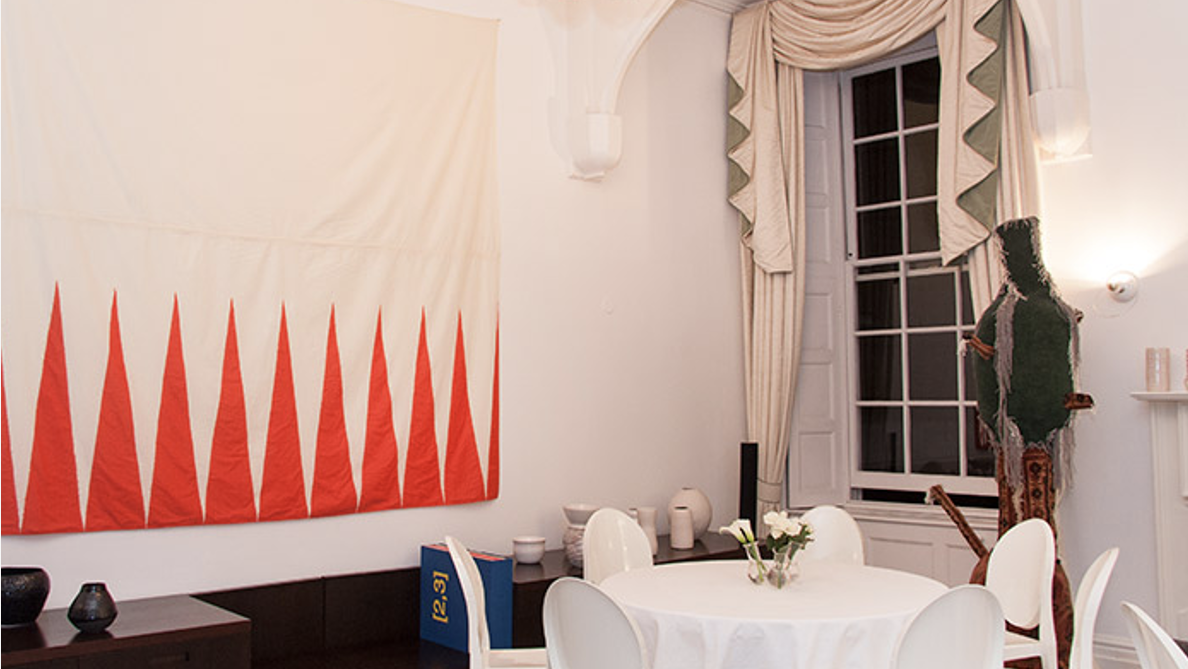
Mai-Thu Perret, Going Places, installation view.
Photo: Mariona Otero. Courtesy of Valeria Napeolone.
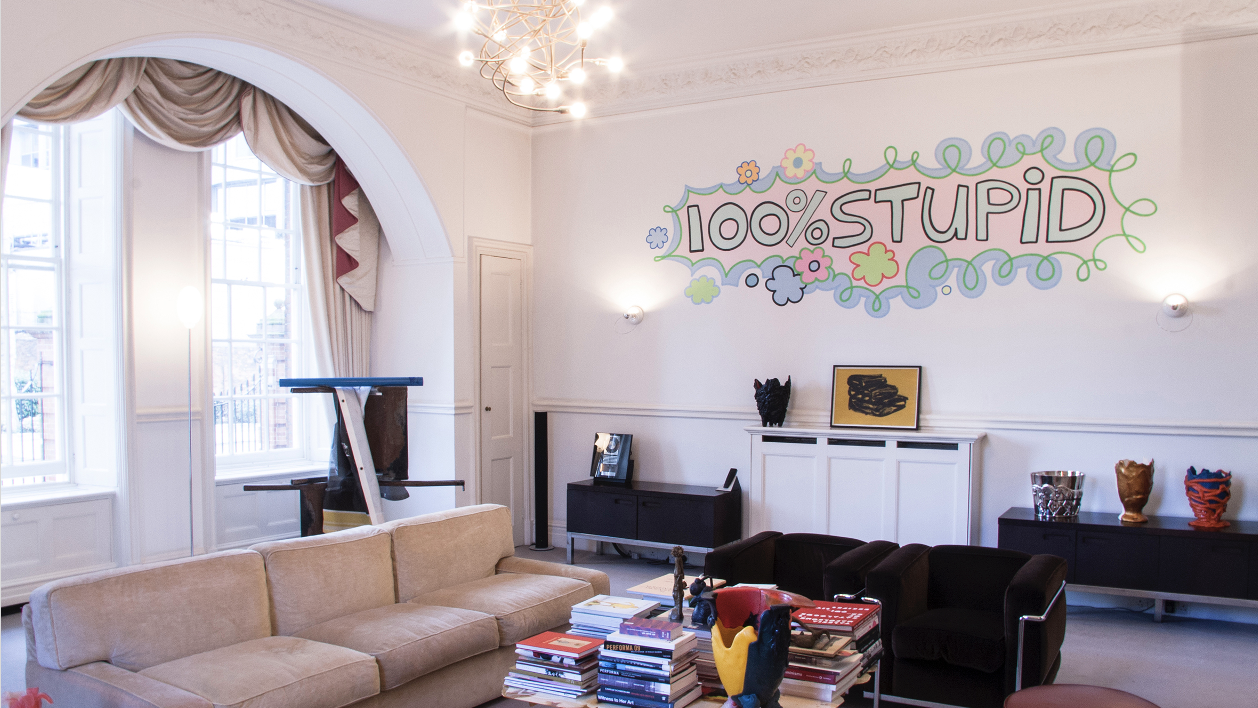
Lily van der Stokker, 100% Stupid, 1991.
Photo: Mariona Otero.
Courtesy of Valeria Napoleone.
You said something that I thought was striking regarding your choices as a collector, obviously the artists you choose, and the investments you make all have a certain amount of risk, and you said: “My whole life is a risk.”
Yes, I don’t know the meaning of a risk, I’m courageous as a collector I can do whatever I want, I can choose the artists that I love and the private collections are interesting because of the of the personal tastes of the collector, they have to reflect the taste of the of the maker of the collection.
Do you collect differently depending on your localization? Is your London collection more influenced by local artists for a particular desire, for example.
I never want the collection to be identified as either European, Italian, British or American, I want to abbreviate international collection. My collection is a very personal journey of my own taste. Apart from the idea of looking at women's practices doesn't have any other criteria. I believe that these artists make a relevant contribution to the language of Contemporary Art nowadays.
You are such an inspiration to many for your patronage, your courage in collecting, your incredible support. If you could give a suggestion to a young collector, what would it be and what do you think is the state of the current art market?
I would advise young collectors to spend a couple of years going to museums, galleries, non-for-profit organisations, just get yourself acquainted with the world of contemporary art, start engaging with galleries, start asking questions, and start understanding your story. Find out about your own taste, and start engaging in conversation, especially find what moves you and what really you are excited about. Also do your research, read about the artist, discuss the artist, look at many pieces, go to studio visits because artists enjoy visiting and, and the conversation with collectors. You don't need to speculate about the artists’ intention, they’re right there.
Do you ever experienced discrimination in response to your collection in the same way that a female artist might from a male biased industry?
No, I cannot compare what female artists go through with their rejection because they expose themselves so much. I could never be an artist, you have to have such thick skin which is why I'm so sympathetic. I know who my allies are, and I know who my enemies are. I'm not supported by everybody because people don't understand, people feel frightened, which I don't mind. I mean, if everybody understood what I do, that means I’m probably not so advanced. In the end, it’s all about great art.
Thank you so much for your insights Valeria! You exemplify how through vision and commitment you can build a purposeful and joyful life within art! We’ll be keeping an eye out on XX and the artists and institutions you continue to champion in the future.